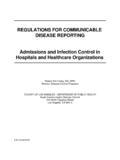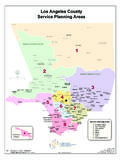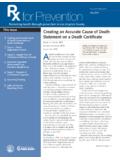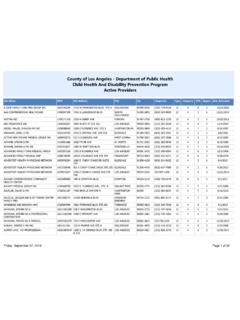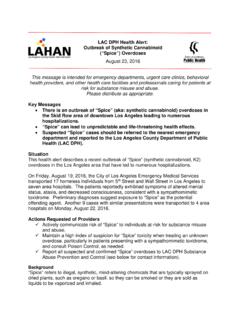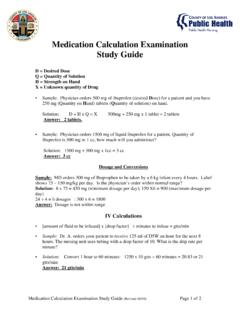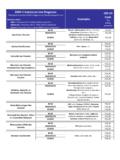Transcription of SCABIES PREVENTION AND CONTROL GUIDELINES
1 ACUTE COMMUNICABLE DISEASE CONTROL PROGRAM SCABIES PREVENTION AND CONTROL GUIDELINES September 2018 FOR HEALTHCARE FACILITIES SCABIES PREVENTION and CONTROL Guideline for Healthcare Settings i TABLE OF CONTENTS I. Introduction .. 1 Information .. 1A. Biology of the SCABIES 1 B. Clinical Presentation .. 2 SCABIES .. SCABIES .. 3C. Epidemiology of SCABIES .. 3 .. Period .. of Communicability .. 4D. Diagnosis .. 4 PREVENTION and CONTROL Program .. Outbreak Management .. 5A. Overview .. 5 B. Summary of Action Steps .. 6 C. Management of Symptomatic Cases .. 8 Healthcare Workers .. Patients/Residents .. 9D. Management of Contacts .. 9 Worker (HCW) Contacts .. Contacts .. 11E. Extending Recommendations for Prophylaxis .. 12 F. Notification of Staff, Visitors and Household Members.
2 12 V. Patient/Resident Transfer to Another Healthcare Facility .. 12 13 Appendices .. 14 A. The Spread of SCABIES .. 15 B. SCABIES Outbreak Management Checklist .. 16 C. SCABIES Skin Scraping Procedure .. 17 D. SCABIES Treatment and Prophylaxis .. 18 a)Application of Scabicides: General Principles .. 18b)Scabicides .. 18 ii SCABIES PREVENTION and CONTROL Guideline for Healthcare Settings Table of Contents (cont.) c)Treatment Regimen: Typical SCABIES Infection .. 19d)Treatment Regimen: Atypical (Norwegian) or Crusted SCABIES .. 19e)Treatment Failures .. 20E. SCABIES Treatment Options .. 21 F. SCABIES Treatment or Prophylaxis with Permethrin (Elimite ).. 22 G. SCABIES Fact Sheet .. 23 H. Healthcare Worker SCABIES Fact Sheet .. 24 I. Contact Precautions and Environmental CONTROL for Patients/Residents with SCABIES .
3 26 J. SCABIES Case/Contact Line List Form: Patients/Residents .. 28 K. SCABIES Case/Contact Line List Form: HCW .. 29 L. Sample Letter to Discharged Patients/Residents .. 30 M. Sample Letter to Physicians of Discharged Patients/Residents .. 31 321 SCABIES PREVENTION and CONTROL Guideline for Healthcare Settings I. INTRODUCTION SCABIES is an ectoparasitic infestation of the skin caused by the human itch mite, Sarcoptes scabiei var. hominis. The actual incidence of SCABIES in Los Angeles County (LAC) is unknown because single occurrences of typical, or classic, SCABIES are not reportable to public health. Outbreaks of SCABIES infestations in healthcare facilities (HCF) and single cases of atypical, or crusted, SCABIES are reportable to public health and present a continuing problem in LAC.
4 While regarded as a nuisance disease by many healthcare professionals, SCABIES outbreaks in HCFs can be extremely costly in terms of direct and indirect costs of outbreak management, poor public relations, and discomfort and anxiety of affected patients, residents, employees, and their family members. Furthermore, secondary bacterial skin infection is a common complication of SCABIES infestation that, in elderly or immunocompromised individuals, can lead to sepsis and even death. Several factors influence the extent of SCABIES transmission within a facility, including the mite load and the required level of care of the source case, as well as the duration of the exposure period. Each HCF SCABIES outbreak is unique and requires an individualized approach. These GUIDELINES provide a rational approach to the PREVENTION and CONTROL of SCABIES in HCF.
5 They are intended to assist HCFs in developing a SCABIES PREVENTION and CONTROL program, and they are based on best practices, state and federal SCABIES GUIDELINES , literature review and the extensive experience of Acute Communicable Disease CONTROL Program (ACDC) INFORMATIONA. Biology of the SCABIES Mite Infestation begins when one or several pregnant female mites are transferred from the skin of an infested person to the skin of an uninfested person. After transfer from the skin of an infested person, or, rarely, from fomites to the skin of an uninfested person, the adult female mite travels on the skin surface at the rate of about 1 inch per minute seeking a burrow site. After finding a suitable location, she burrows into superficial layers of the skin, forming a slightly elevated narrow tunnel where she deposits 2 to 3 eggs daily during her 4 to 6-week life span .
6 The eggs progress through larval and nymphal stages to form adults in 10 to 17 days. The adults migrate to the skin surface and mate. The males die quickly, and the females penetrate the skin and repeat the cycle. The mite requires human skin to complete its life cycle and is unable to survive off the host at room temperature for more than 3 to 4 days. 2 SCABIES PREVENTION and CONTROL Guideline for Healthcare Settings B. Clinical Presentation SCABIES infestations generally present clinically as typical (classic, regular) or atypical (crusted, keratotic, hyperkeratotic or Norwegian). 1. Typical SCABIES Patients/residents with typical SCABIES usually have only 10 to 15 live adult female mites on the body at any given time. Usually only one or two mites, and frequently none, are recovered from skin scrapings.
7 Intense pruritus, usually worse at night, and a papular rash with or without burrows occur. The rash and pruritus result from an immune-mediated delayed hypersensitivity reaction to the mite, its eggs and fecal material. Areas of the body commonly involved are wrists, finger webs, antecubital fossae, anterior axillary folds, breasts, waistline, lower abdomen, genitals, and Figure 1. SCABIES Lifecycle 3 SCABIES PREVENTION and CONTROL Guideline for Healthcare Settings buttocks. The scalp and face are rarely involved in adults, but may be observed in young children with ScabiesWhen diagnosis and treatment are delayed, SCABIES can have an unusual or atypical presentation, involving heavy infestation with hundreds to millions of mites. When extensive hyperkeratotic skin lesions with crusting and scaling develop, the infestation is called atypical SCABIES .
8 Atypical SCABIES is highly contagious because thousands of mites are imbedded in the thick crusts and are easily shed in scales and flakes from affected skin. Atypical clinical presentations are more prevalent in institutionalized or debilitated patients/residents, or those who are immunosuppressed from underlying disease or drug therapy. Atypical SCABIES is commonly misdiagnosed by clinicians, and patients/residents with atypical SCABIES may develop symptoms in as little as a few days. C. Epidemiology of SCABIES 1. TransmissionTransfer of the mite is usually from one person to another by direct skin-to-skin contact. Itmay also be transmitted through sexual contact. Procedures such as bathing a patient/resident, applying body lotions, back rubs, or any extensive hands-on contact can provide an opportunity for mite transmission.
9 Mites may also be transmitted via clothing, bed linen or other fomites. Fomites play a minor role in situations where the infestation in the source case is typical SCABIES ; the inanimate environment of patients/residents with atypical SCABIES , however, has been shown to be heavily contaminated with mature and immature mites. In HCF, SCABIES may be introduced into the facility by a newly admitted resident with an unrecognized infestation or by visitors or healthcare workers as a result of contact in the home or community with a person who has SCABIES . PeriodIn a previously unexposed healthy individual, the interval between exposure and the onset ofitching is usually 2-6 weeks. In persons who have been sensitized to the mite by a previous 4 SCABIES PREVENTION and CONTROL Guideline for Healthcare Settings infestation, re-exposure may produce symptoms in 48 hours or less (owing to prior sensitization or contact with the mite and its saliva and feces).
10 Following exposure to a source case with atypical SCABIES involving extremely large numbers of mites, the incubation period may be reduced from the usual time of 2-6 weeks to as little as a few of CommunicabilitySince the SCABIES mite is an ectoparasite, an exposed individual is potentially immediatelyinfectious to others, even in the absence of symptoms. Cases are communicable from thetime of infestation until mites and eggs are destroyed by Diagnosis Definitive diagnosis requires microscopic identification of the mite and/or its eggs or fecal pellets on specimens collected by skin scraping, biopsy or other means (Appendix C, SCABIES Skin Scraping Procedure ). The yield from skin scrapings is highly dependent on the experience of the operator and the severity of the infestation.
